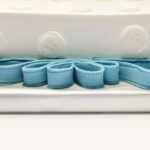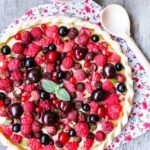Decorating a cake without crumbs is an essential skill for any baker looking to elevate the presentation of their sweet creations. Crumbs can detract from the overall appearance and smooth finish of a decorated cake, making it crucial to master techniques that minimize their presence. By learning how to prevent crumbs from ruining your cake decorations, you can achieve a professional-looking result that will impress both visually and taste-wise.
The presence of cake crumbs can significantly impact the final look of your decorated creation, leading to a messy and unpolished appearance. Whether you are frosting a birthday cake or preparing a special occasion dessert, ensuring a crumb-free finish is key to achieving a visually appealing outcome. In this article, we will delve into the importance of decorating a cake without crumbs and provide valuable tips and techniques to help you achieve impeccable results every time.
Understanding the basics of cake crumbs is crucial in mastering the art of decorating without imperfections. Different types of cakes may produce varying amounts of crumbs, with some being more prone to crumbling than others.
By learning how to properly handle and prepare your cake before decorating, you can minimize the risk of dealing with unwanted crumbs during the frosting process. Stay tuned as we explore the fundamentals of preventing crumbs while decorating cakes and delve into helpful strategies for achieving flawless results.
Understanding the Basics
When it comes to decorating a cake without crumbs, understanding the basics of the different types of cake crumbs is essential. There are two main types of crumbs that can affect the decorating process: loose crumbs and fine crumbs. Loose crumbs are larger pieces that can easily detach from the cake when frosting is applied, while fine crumbs are smaller particles that can create a rough texture if not properly addressed.
To prevent the formation of excess crumbs while decorating a cake, it is crucial to handle the cake carefully and use proper techniques during the preparation process. Start by properly leveling the cake layers to ensure a flat surface for decorating. Additionally, allowing the cake to cool completely before frosting can help reduce the likelihood of creating additional crumbs.
One effective method to minimize loose crumbs when decorating a cake is to apply a crumb coat. A crumb coat is a thin layer of frosting or icing that seals in any loose crumbs on the surface of the cake.
This initial layer acts as a foundation for the final decorations and helps create a smooth base for frosting application. Use an offset spatula to apply a thin layer of frosting over the entire cake, then chill it in the refrigerator until firm before applying additional layers of frosting.
Preparing the Cake
When it comes to decorating a cake without crumbs, proper preparation is key. One essential step in this process is ensuring that the cake is leveled and cooled correctly to prevent excessive crumbs. Here are some tips on how to prepare your cake for decorating:
- Leveling the Cake: Before decorating, it is important to ensure that your cake layers are level. Use a cake leveler or a serrated knife to carefully trim off any domed tops. This will create a smooth surface for frosting and minimize the risk of creating crumbs during the decorating process.
- Cooling the Cake: After baking your cake layers, allow them to cool completely in the pans before removing them. Once removed, transfer the cakes to a wire rack and let them cool completely before starting the decoration process. Cooling the cakes properly helps prevent them from crumbling when handling them.
- Chilling the Cake: For added insurance against crumbs, consider chilling your cake layers in the refrigerator for an hour before decorating. Chilled cakes are firmer and less likely to produce crumbs when applying frosting or decorations.
By following these tips on properly leveling and cooling your cake, you can set yourself up for success when decorating without crumbs. Taking the time to prepare your cake correctly will ultimately result in a professional-looking finish that is free of unwanted crumb distractions.
Crumb Coating
When it comes to how to decorate a cake without crumbs, the crumb coating step is essential for achieving clean and flawless results. To begin, apply a thin layer of frosting all over the cake using an offset spatula.
Make sure to work quickly but gently to prevent lifting any crumbs from the surface of the cake. Once the entire cake is covered with a thin layer of frosting, place it in the refrigerator for about 15-20 minutes to allow the crumb coat to set.
After chilling the crumb-coated cake, you can proceed with applying the final layer of frosting or decoration without worrying about pesky crumbs ruining your design. This step-by-step guide on crumb coating will help you achieve professional-looking results and take your cake decorating skills to the next level.
| Crumb Coating Tips | Details |
|---|---|
| Leveling Cake | Start by ensuring your cake has an even surface by leveling the top before applying any frosting. |
| Cooling Cake | Allow your cake to cool completely before starting with the crumb coating process. |
| Chilling Cake | After applying the initial layer of frosting for crumb coating, chill the cake in the refrigerator for 15-20 minutes. |
Frosting Techniques
When it comes to decorating a cake without crumbs, the choice of frosting plays a crucial role in achieving a smooth and flawless finish. One popular option is crusting buttercream, which forms a firm outer layer when left to set, making it easier to work with and minimizing the risk of picking up cake crumbs.
To create a crusting buttercream, ensure that your frosting consistency is not too thin or too thick – aim for a spreadable yet sturdy texture that will hold its shape.
Another excellent frosting method to consider is using ganache. Made from chocolate and heavy cream, ganache has a rich and velvety texture that can cover cakes beautifully while preventing crumbs from peeking through. When working with ganache, it’s essential to let it cool slightly before pouring or spreading it onto the cake to achieve a smooth and even finish.
In addition to crusting buttercream and ganache, other options like Swiss meringue buttercream or fondant can also help you decorate your cake without crumbs. Experiment with different frostings to find one that suits your taste preferences and decorating style best. Remember that practice makes perfect, so don’t be discouraged if your first few attempts aren’t flawless – with time and patience, you’ll master the art of decorating cakes without any pesky crumbs interfering with your design.
| Frosting Method | Description |
|---|---|
| Crusting Buttercream | Forms a firm outer layer when set, minimizes crumbs, spreadable yet sturdy texture. |
| Ganache | Made from chocolate & heavy cream, rich & velvety texture, covers cakes beautifully. |
| Swiss Meringue Buttercream | Smooth & creamy texture, stable for piping intricate designs on cakes. |
Tools of the Trade
When it comes to decorating a cake without crumbs, having the right tools and utensils can make all the difference in achieving a smooth and professional-looking finish. One essential tool for this task is the offset spatula, which allows for precise spreading of frosting without disturbing the crumb coat underneath. This angled spatula is perfect for creating clean edges and smooth surfaces on your cake layers.
Another handy tool to have in your cake decorating arsenal is a bench scraper. This tool is great for smoothing out frosting on the sides of the cake while also helping to create sharp corners. The bench scraper can also be used to level off excess frosting and ensure that your cake has a clean and polished appearance.
In addition to these tools, having a turntable can greatly aid in the decorating process by allowing you to easily rotate the cake as you work on different sections. This rotation helps ensure even coverage of frosting and allows you to apply decorations evenly around the entire cake. By investing in these recommended tools, you’ll be well-equipped to decorate a cake without crumbs and achieve professional results every time.
Decorative Techniques
When decorating a cake without crumbs, it is essential to consider creative techniques that not only enhance the appearance of your cake but also help cover up any imperfections. Piping buttercream flowers is a popular and effective way to add a decorative touch while disguising any remaining crumbs on the surface of the cake.
By using different piping tips and techniques, you can create beautiful floral designs that not only look visually appealing but also distract from any crumbs that may be present.
Another creative idea for decorating cakes without crumbs is to use fondant accents. Fondant is a versatile and pliable icing that can be molded into various shapes, patterns, and designs to adorn the cake. By strategically placing fondant accents such as bows, ribbons, or edible decorations on the cake, you can draw attention away from any potential crumb issues. Additionally, fondant provides a smooth and clean canvas for decorating, making it an ideal choice for covering up imperfections.
Incorporating both buttercream flowers and fondant accents into your cake decorating repertoire can elevate your creations to new levels of artistry while effectively camouflaging any leftover crumbs. Experiment with different colors, shapes, and styles to find combinations that complement the overall theme of your cake design. These decorative techniques not only help cover up crumbs but also add depth, texture, and visual interest to your cakes, ensuring a stunning presentation that will impress everyone who sees and tastes your masterpiece.
Troubleshooting
Decorating a cake without crumbs can be a challenging task, but with the right techniques and tools, you can achieve a smooth and professional finish. However, even with proper preparation and execution, some common issues may still arise during the decorating process. One such issue is the possibility of crumbs appearing in the final layer of frosting. This can be frustrating after all your hard work, but there are ways to address this problem.
One effective way to prevent crumbs from ruining your final layer of frosting is to chill the cake before applying it. By placing the cake in the refrigerator for a short period of time, the frosting will adhere better to the surface and minimize any loose crumbs that may come loose during frosting.
Additionally, using a crumb coat as mentioned earlier in the article can also help seal in any crumbs and provide a smoother base for your final layer of frosting.
In conclusion, mastering the art of decorating a cake without crumbs requires patience, practice, and attention to detail. By following the tips outlined in this article – from properly preparing the cake to using crusting buttercream or ganache for frosting – you can create stunning cakes that look as good as they taste. With the right tools and techniques at your disposal, you can confidently decorate cakes that are free from pesky crumbs and impress any audience with your baking skills.
Frequently Asked Questions
How Do You Prevent Crumbs When Frosting a Cake?
To prevent crumbs when frosting a cake, it’s essential to start with a completely cooled cake. Applying a thin layer of frosting as a base coat, known as the crumb coat, can help lock in any loose crumbs before adding the final layer of frosting.
Using an offset spatula or bench scraper can also ensure smooth and even coverage without disturbing the cake underneath.
How Do You Decorate a Cake Without Crumbling?
Decorating a cake without crumbling requires some patience and gentle handling. After applying a crumb coat and letting it set, carefully spread the final layer of frosting using smooth strokes to avoid creating excess crumbs. Using chilled tools like spatulas or piping bags can also help maintain the structural integrity of the cake while decorating, reducing the likelihood of crumbling.
Can I Skip the Crumb Coat?
While it is possible to skip the crumb coat when frosting a cake, especially if you are in a hurry or working with a recipe that doesn’t require it, be prepared for potential challenges. Skipping this step may result in more visible crumbs in the final frosting layer and make it difficult to achieve a smooth finish.
However, if you are confident in your frosting skills and have baked a cake with minimal crumbly texture, skipping the crumb coat might work out fine for you.

Welcome to my blog about home and family. This blog is a place where I will share my thoughts, ideas, and experiences related to these important topics. I am a stay-at-home mom with two young children. I hope you enjoy reading it! and may find some helpful tips and ideas that will make your home and family life even better!





